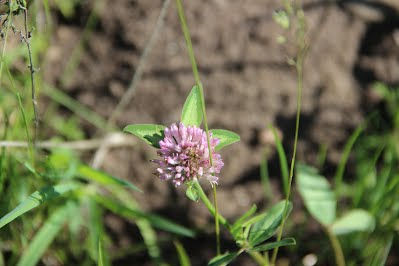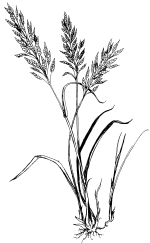
Plants of Prairie Creek
Click on an image to find out more about the plant.
Tallgrass Prairie is the most endangered ecosystem in North America. In the 1800s, there were vast tracts of prairie in Minnesota. Now, less than 1% remains.
Dry Hill Oak Savanna is listed as critically imperiled by the Minnesota Department of Natural Resources. In 2010, there were only 13 occurrences of this ecosystem documented in the Natural Heritage Information System in the state.
If visitors have photos of birds or animals taken at Prairie Creek WMA, please share them with Craig Koester.
Pictures on these pages are arranged by season. All were taken on the site to give an impression of the variety of native species that can be found there.
April

Anemone patens This flower is one of the earliest to bloom in the spring. Its colors range from pale blueish-purple to white. It gets its name because it usually appears around the "pasque" season of Passover and Easter.


Pasqueflower
Prairie Buttercup
May

The White Cockle, or Silene latifolia (also known as the White Campion), is a non-native, short-lived perennial weed that blooms from May through September. Their white flowers are odorous and open in the evening and close by noon. (Photo taken on 5/23/2015)

Malus ioensis Prairie crabapple is rare in Minnesota. Its common range is in southern Iowa and Wisconsin, Missouri, and Illinois. It bears pink blossoms in spring and red fruit in the fall.

Malus ioensis Prairie crabapple is rare in Minnesota. Its common range is in southern Iowa and Wisconsin, Missouri, and Illinois. It bears pink blossoms in spring and red fruit in the fall.

The Philadelphia Fleabane, or Erigeron philadelphicus, is a native Minnesota wildflower that blooms from May to June and grows in moist soil. (Photo taken on 5/31/2015)
White Cockle
Prairie Crabapple (pink)
Prairie Crabapple and Hawthorn
Philadelphia Fleabane

Sisyrinchium campestre The blossoms on this flower are about half to three -quarters of an inch in diameter. In color they range from pale blue to white. There are six petals. The leaves are narrow, grasslike blades.

Sisyrinchium campestre The blossoms on this flower are about half to three -quarters of an inch in diameter. In color they range from pale blue to white. There are six petals. The leaves are narrow, grasslike blades.

The Hawthorn flowers' white blossoms usually bloom in May. In the fall, the Hawthorn produces a red fruit. There are a number of different types of Hawthorn in Minnesota. Fireberry Hawthorns (pictured here) have broad crowns and spikes on their branches. (Photo taken on 5/23/2015)

Crataegus Hawthorn has the white blossoms in the picture above. A close-up of the blossoms is pictured on the right. In the fall it produces a red fruit. There are a number of species of Hawthorn in Minnesota. Those on the savanna have a broad crown, giving it a distinctive appearance. They have spikes or "thorns" on their branches.
Prairie Blue-eyed Grass
Fireberry Hawthorn
Hawthorn (White)

Lithospermum canescens This bright yellow flower blooms from late spring to early summer. It grows from 5 - 14 inches tall. By midsummer it produces small egg-shaped nutlets that are yellowish white. That is the basis of its scientific name, which means "stone seeds."

A low-growing, spreading legume, the Ground Plum, or Astragalus crassicarpus, blooms in May and June with clusters of pea-like blossoms of lavender, purple and white. The thick-walled seed pods typically rest on the ground. (Photo taken on 5/16/2015)

Antennaria neglecta The flower gets its name from its grayish white head, which looks like the furry paws of a cat. There are male and female flowers on separate plants. The males are somewhat less furry and have brown stamens in the flowers. The leaves are covered with wooly hairs, which gives them a gray-green color.

Antennaria neglecta The flower gets its name from its grayish white head, which looks like the furry paws of a cat. There are male and female flowers on separate plants. The males are somewhat less furry and have brown stamens in the flowers. The leaves are covered with wooly hairs, which gives them a gray-green color.
Hoary Puccon
Ground Plum
Pussy Toes

The Prairie Ragwort, or Packera plattensis, is a biennial or short-lived perennial that blooms when it is six to twelve inches tall from May to August. It grows generally in dry, sandy prairie. (Photo taken on 5/31/2015)

Geum triflorum This early blooming wildflower produces nodding, urn-shaped flowers. Once pollinated, the flower stalk straightens and produces long plumes that look like tufts of smoke. Because of its appearance, it is sometimes called "Old Man's Whiskers."

Geum triflorum This early blooming wildflower produces nodding, urn-shaped flowers. Once pollinated, the flower stalk straightens and produces long plumes that look like tufts of smoke. Because of its appearance, it is sometimes called "Old Man's Whiskers."

The Wild Strawberry, or Fragaria vesca, is a common creeping plant that grows just about anywhere. It can be up to six inches tall. (Photo from 5/16/2015)
Prairie Ragwort
Prairie Smoke
Prairie Smoke
Wild Strawberry

The lovely Prairie Violet, or Viola pedatifida, blooms in May. Its skinny leaves differentiate it from the common violet, which also grows on the prairie. (Photo taken on 5/16/2015

The Yellow Goat's Beard, or Tragopogon dubius, is a non-native biennial plant that can grow up to 3 feet tall. Goat's Beard blooms from May through September and is found throughout Minnesota. The Goat's Beard isn't as aggressive as most non-native plants but it does invade prairie habitat and can crowd out other native prairie plants. (Photo taken on 5/31/2015)
Prairie Violet
Yellow Goat's Beard
June

Zizia aurea Both types of Alexanders produce golden flower heads in late spring. The difference is that one is named for its heart-shaped leaves, while the other has narrower leaves with jagged edges. They bloom in late May to early June.

Zizea aptera Both types of Alexanders produce golden flower heads in late spring. The difference is that one is named for its heart-shaped leaves, while the other has narrower leaves with jagged edges. They bloom in late May to early June. (Not to be confused with the invasive wild parsnip, which blooms in later June and early July.)

The Canada Anemone, or Anemone canadensis, is a native Minnesota wildflower that blooms in May and June and sprouts in moist environments. (Photo taken on 5/31/15)

The Red Clover, or Trifolium pratense, is a perennial weed that blooms from June to September. A Red Clover plant has several flower heads on branding stems. (Photo taken on 5/31/2015)
Golden Alexander
Canada Anemone
Heart-Leafed Alexander
Red Clover

Known as the "aristocrat" of flowering trees due to its beautiful white blossoms, the White Dogwood, or Cornus florida, is a native flowering tree with a four-season interest. (Photo taken on 5/31/2015)

The Field Mustard, or Brassica rapa, is a non-native annual weed that blooms from June to July. (Photo taken on 5/16/15)

Amorpha canescens Shown here in the early summer, Lead-plant is a semi-woody shrub that can grow from 1-2 feet high. The plant was because of its lead-gray color at certain seasons.

The Prairie Phlox, or Phlox pilosa, is a perennial native plant that blooms from May to July, peaking in June. When the seeds of the Phlox are ripe, the oval capsule containing them explodes, flinging seeds away from the plant. (Photo taken on 5/31/2015)
White Dogwood
Field Mustard
Lead-plant
Prairie Phlox

Tradescantia occidentalis Prairie Spiderwort blooms in early summer. It typically has only a few flowers open at a time. The petals open in the morning, but they wilt around midday, so the appearance of the plant changes during the course of a single day.
Spiderwort
July

Zigadenus elegans This white flowering plant stands between 4 to 28 inches tall. It is named "death" camas because all parts of the plant contain toxic alkaloids that would sicken cattle when eaten.


